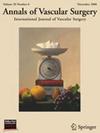Midterm Morphological Change of Kommerell's Diverticulum after Hybrid Thoracic Endovascular Aortic Repair
IF 1.4
4区 医学
Q3 PERIPHERAL VASCULAR DISEASE
引用次数: 0
Abstract
Background
Kommerell's diverticulum (KD) is associated with a high incidence of right-sided aortic arch (RAA). Hybrid thoracic endovascular aortic repair (TEVAR) is an effective and less invasive alternative to open repair. However, the long-term results regarding KD diameter regression or symptom improvement remain inadequately described.
Methods
Nine patients underwent TEVAR for KD associated with RAA between January 2016 and September 2023 at our university hospital and affiliated institutions. A hybrid procedure was performed to exclude KD by blocking the proximal blood flow with TEVAR and distal blood flow with embolization of the aberrant subclavian artery. Simultaneously, extra-anatomical bypass surgery was performed to revascularize the covered supraarch vessels.
Results
The patients' mean age was 65.2 years, and 6 patients were men. Two patients presented with dysphagia, whereas the rest were asymptomatic. The mean diameter and distance to the opposite aortic wall (OAW) of KD were 32.1 mm and 56.2 mm, respectively. For revascularization of the covered supraarch vessels, 6 and 2 patients underwent total debranching with sternotomy and extra-thoracic bypass (bilateral common carotid artery–axial artery bypass), respectively. The 30-day and in-hospital mortality rates were 0%, with no instances of cerebral infarction or spinal cord ischemia. The mean follow-up period was 3.2 years. The survival and avoidance rates of aortic events were 100% at 1 and 3 years. Follow-up computed tomography scans showed no endoleaks; however, 1 (11.1%) type 2 endoleak from the aberrant left subclavian artery occurred 1 week postoperatively, necessitating additional coiling. Seven patients were followed up for more than 1 year, with 5 experiencing reductions of more than 3 mm in KD diameter, distance to the OAW, or both.
Conclusions
Although further follow-up and investigations are needed, TEVAR may be a safe and effective surgical treatment for KD associated with RAA.
杂交胸腔内主动脉瓣修复术后 Kommerell's 虹膜憩室的中期形态变化。
目的:科默梅尔氏憩室(KD)与右侧主动脉弓(RAA)的高发病率有关。胸腔内血管主动脉混合修补术(TEVAR)是一种有效且创伤较小的开胸修补术替代方法。然而,有关 KD 直径消退或症状改善的长期结果仍未得到充分描述:2016年1月至2023年9月期间,9名患者在我校附属医院接受了TEVAR手术治疗伴有RAA的KD。为了排除 KD,我们采用了混合手术,通过 TEVAR 阻断近端血流,并通过栓塞异常锁骨下动脉阻断远端血流。同时,还进行了解剖外搭桥手术,对覆盖的弓上血管进行血管再通:患者的平均年龄为 65.2 岁,其中六名患者为男性。两名患者出现吞咽困难,其余患者无症状。KD 的平均直径和到对侧主动脉壁的距离分别为 32.1 毫米和 56.2 毫米。为了对被覆盖的主动脉上血管进行血管再通,6 名患者和 2 名患者分别接受了胸骨切开术和胸外搭桥术(双侧颈总动脉-轴动脉搭桥术)。30天死亡率和住院死亡率均为0%,无脑梗塞或脊髓缺血病例。平均随访时间为 3.2 年。1年和3年的存活率和主动脉事件避免率均为100%。随访计算机断层扫描显示没有内漏;但术后一周发生了一起(11.1%)来自左锁骨下动脉畸形的 2 型内漏,因此需要进行额外的卷曲。对7名患者进行了1年以上的随访,其中5人的KD直径、与对侧主动脉壁的距离或两者均缩小了3毫米以上:尽管还需要进一步的随访和研究,但 TEVAR 可能是治疗伴有 RAA 的 KD 的一种安全有效的手术疗法。
本文章由计算机程序翻译,如有差异,请以英文原文为准。
求助全文
约1分钟内获得全文
求助全文
来源期刊
CiteScore
3.00
自引率
13.30%
发文量
603
审稿时长
50 days
期刊介绍:
Annals of Vascular Surgery, published eight times a year, invites original manuscripts reporting clinical and experimental work in vascular surgery for peer review. Articles may be submitted for the following sections of the journal:
Clinical Research (reports of clinical series, new drug or medical device trials)
Basic Science Research (new investigations, experimental work)
Case Reports (reports on a limited series of patients)
General Reviews (scholarly review of the existing literature on a relevant topic)
Developments in Endovascular and Endoscopic Surgery
Selected Techniques (technical maneuvers)
Historical Notes (interesting vignettes from the early days of vascular surgery)
Editorials/Correspondence

 求助内容:
求助内容: 应助结果提醒方式:
应助结果提醒方式:


